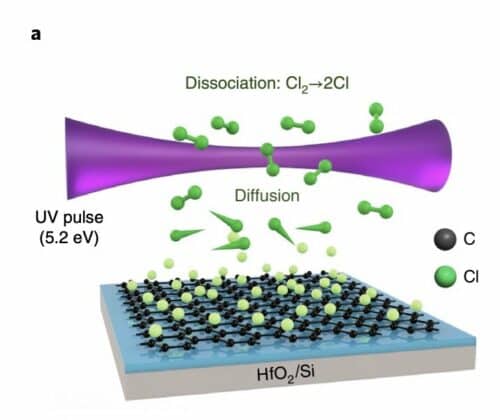Researchers introduced a laser-based chlorination method to produce highly doped patterns in graphene

Implementation of this chlorination process is carried out by Rho and his colleagues with the use of an ultraviolet (UV) nanosecond laser beam, with a wavelength of λ=213 nm (5.8 eV). This beam was aligned parallel to their sample under a flowing Cl2 gas. The targeted UV pulsed laser can photochemically dissociate the Cl2 molecules, producing Cl radicles that diffuse throughout the graphene sample. The researchers analyzed the measurements to determine their consequences on the charge carrier density and mobility. Similarly, a photothermal process for the removal of the Cl doping agent was applied by the team. The process includes a continuous-wave (CW) green laser with a wavelength of (λ=532 nm (2.3 eV)), applied in the normal direction with a focal size of 2 μm (1/e2 ).
“Our approach uses two lasers—with distinct photon energies and geometric configurations—that are designed for chlorination and subsequent chlorine removal, allowing highly doped patterns to be written and erased without damaging the graphene,” Rho and his colleagues wrote in their paper.
This reversible doping method was evaluated by the team by applying re-writable photoactive junctions for graphene-based photodetectors. The laser-assisted chlorination method resulted in ultrahigh-doping concentrations, resulting in a minimal drop in the mobility of charge carriers. In the removal procedure, the Cl dopants were fully erased without affecting the structural features of the graphene.
“Conventional methods based on substitutional doping or surface functionalization result in the degradation of electrical mobility due to structural disorder, and the maximum doping density is set by the solubility limit of dopants,” Yoonsoo Rho and his colleagues wrote in their paper. “We show that a reversible laser-assisted chlorination process can be used to create high doping concentrations (above 3 × 1013 cm−2) in graphene monolayers with minimal drops in mobility.”
The team of researchers is aiming to use this laser-assisted approach for introducing different doping elements in 2D van der Waals materials. This will allow the reversible introduction of valuable electronic functionalities for optoelectronic devices.
Click here for the Published Research Paper







